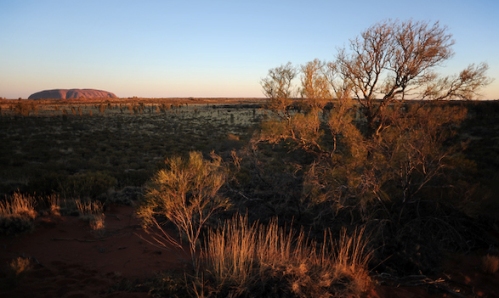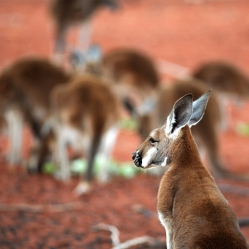by Ellen and David Hill

There underground, nestled like silkworms in a mulberry leaf, is the witchetty grub, all fat and creamy, filled with a protein-rich almond-flavoured ooze.
At eye level there’s a Grevillea bloom, pregnant with syrupy nectar, already dripping its golden sweetness on your fingers. The air hangs heavy with the heady odour of dozens of bush oranges scattered in haphazard disarray on the ground.
Welcome to Doug Taylor’s supermarket in Australia’s Alice Springs Desert Park—right in the middle of the most arid continent on earth.
Here, the uninitiated can learn how to fill their trolley in a park that promotes conservation and teaches how to properly use desert resources—parts of the Aboriginal culture for thousands of years.
Uncle Doug, an elder in the community and a cross-cultural guide in Australia’s Northern Territory, relishes his role of sharing with visitors how, for millennia, one of the world’s oldest living cultures has fed itself well on “bush tucker,” or food found in the wild bush of Australia—from kangaroo to crocodile, from nuts to grubs.
 “We love to be able to just talk to people and give them the opportunity to ask questions. Don’t feel uncomfortable about asking,” he says. “If I can change the perception of just one person, then I am doing my job.”
“We love to be able to just talk to people and give them the opportunity to ask questions. Don’t feel uncomfortable about asking,” he says. “If I can change the perception of just one person, then I am doing my job.”
There’s no kaleidoscope of shiny tins covered with colorful labels vying for attention in this supermarket in the “never-never.” No goods positioned at head height to catch the eye. No mindless elevator music to hold shoppers captive in a plastic and neon world.
No, in the Outback, the famished must rummage for food. They must dig deep. The hunter must follow the example of the hunted. They must toil diligently and constantly for every mouthful. But those who persevere will never go hungry.
The witchetty grub is the most well known of bush foods. Up to 12 centimeters long and 3 centimeters wide, it lives in the roots of the Witchetty Bush.
Today, Larapinta Primary School students in Alice Springs show us how to find the wiggling critters, along with Bush Banana, Honey Ant, and Bearded Dragon—all Aboriginal sources of food.
To find witchetty grubs, student Jamey says, “You find a tree with little cracks in the ground around it. You dig the roots out with a crowbar or a kudra (digging stick). Then you break the roots in half and see if there are any witchetty grubs inside. You can eat them without cooking or cooked. They taste like eggs. Eating witchetty grubs makes you get energy because it makes your blood strong and move faster.”
Back in the park, Uncle Doug grabs a generous handful of native lemongrass. “Here,” he says. “Get a big handful, crush it up, let it soak in a dish of water for half an hour or so, then drink or gargle it, although it doesn’t taste that flash.” The plant, which grows along the riverbank, helps clear the nose.

A few steps on he grabs a handful from another shrub. The medicinal apple bush is ground up and mixed with animal fat and rubbed on the chest. “Or you can use it as a pillow.” When inhaled, the vapors clear the nose.
He walks on, picking bits and pieces from plants as he goes, explaining each one as an aside to our main conversation on the importance of water in the desert. “See this here? This is striped mint bush (medicine). Here’s emu bush. You make a body rub out of it. And this is rock fuchsia. It’s used as a skin wash to rid the body of parasites like scabies.”
Thirsty? At first glance, the desert appears devoid of moisture. The red dirt scorched dry by the sun is flung high into the air by the breeze.
Look closer.
Wherever there’s spiny sedge, which sends down long roots to underground water, or Spinifex, which uses any moisture to grow on rocky outcrops, there’s bound to be water below the surface.
“You might have to dig a meter, which is hard work in 40 degree Celsius heat (about 104 degrees Fahrenheit), but there’s an easier way.” Just follow the animal tracks and see where they have dug and scratched their way to water, Uncle Doug says.

Location: Larapinta Drive, Alice Springs, Northern Territory, Australia
Tel: +61 8 8951 8788, email: asdp@nt.gov.au, www.alicespringsdesertpark.com.au.
Admission: AU$20 adults, $10 children (5-15), $14 student/concession, $16 seniors, $35 economy family (1 adult, up to 2 children), $55 super economy (2 adults, up to 4 children)
Find out how to find food in the bush on the students’ bush tucker website, at http://www.mjhall.org/bushtucker.
Ellen Hill is a Sydney, Australia-based journalist with 15 years’ experience in the field. She and photographer husband David love to travel their world as Deep Hill Fine Art Media, soaking up new experiences and meeting fascinating people with their son.
David’s photographic work can be viewed at www.deephill.com.au.
If you wish to purchase this article for your publication, click here to contact the author directly.